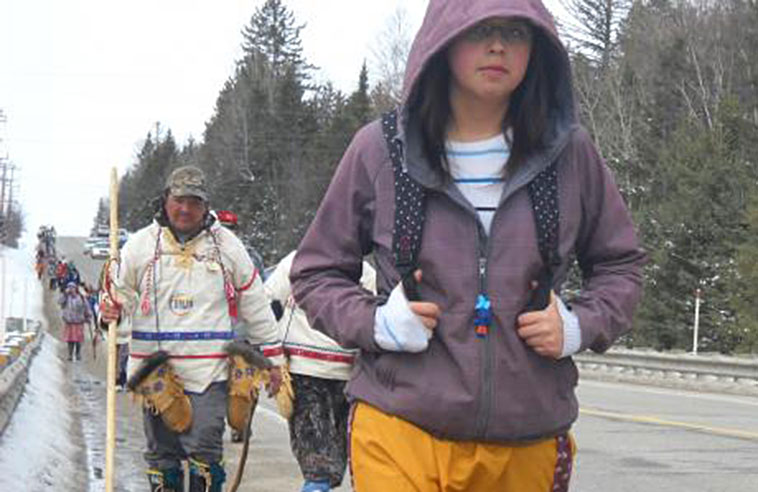
Seemingly a passive act on the surface, underneath the walk was a revolutionary act akin to escaping a residential school.
“At first the light wavering, glancing over us.
Then it clenched to a fist of light that pointed,
serached out, divided us.
Each took the beams like direct
blows the heart answers.
Each of us moved forward alone.
-Louise Erdrich, Jacklight
January 16, 2013. Whapmagoostui, Quebec. -34 Celsius. A bitter wind. The expanse of snow almost blinding white under the arc of the short winter sun. Seven men pause. Before them lie 1600 kilometers of plains, forest, frozen rivers and lakes, roads, towns and highways and their final destination, Ottawa.
The Cree have always walked. It is what Gerald Vizenor would refer to as an ‘act of survivance.’ A need. It is putting things in order. It is sating the instinct to see what is over the next horizon. It is fulfilling an instinctual awareness that the hunting is better over there. It has been this way since time immemorial. It must be again.
The “original seven,” as they would became known — David Kawapit, 18; Geordie Rupert, 21; Raymond (Bajoo) Kawapit, 20; Stanley George Jr., 17; Travis George, 17; Jordon Masty, 19, and Johnny Abraham, 19 — were following in ancestral tracks. Guided by 46-year-old Isaac Kapawit, the “white wizard”, they would face an arduous challenge. But then, challenge was not new to many of these young men. They had seen much in their short years. They had experienced loss. They had witnessed events that were not in balance or positive.
But, in the act of putting one foot in front of the other for 68 days, they were mapping a new redress, an act of defiance against complacency; a trek across colonial boundaries; amanifestation of hope and change. Mostly, even though on that cold day in January they had no way of knowing this, they were about to inspire thousands.

In retrospect, the walk of Nishiyuu was more than a walk. It was also a digital journey via social media. Thousands on Facebook and Twitter would follow the trek from its beginning on a frigid start in northern James Bay to its arrival in the nation’s capital on a warm, spring day in March. When the walkers departed, Idle No More was at its zenith, on the front pages and TV screens with hunger strikes, flash mob round dances and blockades. The so-called “hashtag revolution” had begun and it had inspired these young Cree men from northern Quebec.
Bruce Chatwin wrote, “travel does not merely broaden the mind. It makes the mind.” There is no better example than the Nishiyuu Walkers. By the end of the heroic trek, and heroic it was, more than 270 Indigenous youth had joined them. They were compelled by a simple message of hope and unity that resonated in many communities along the way. As the 68 days unfurled, the number of walkers grew, each community along the way adding numbers to it, and soon the caravan of youth stretched for miles.
There was likely not a single one of those nearly 300 youth who had not witnessed, or felt first-hand, the debilitating effects of reserve life: boredom, dysfunction, isolation, addiction, abuse, or suicide. These are all too prevalent in the sedentary enclosures that we call the ‘reserve’ and that affect so many northern communities. Added to this is the loss of knowledge of how to live off the land, the boom and bust cycles of mining and its despoliation, and the fact that there is simply “no where to go.” Take all this under consideration and perhaps one can begin to grasp the essential relevance of the Nishiyuu Walk.
Seemingly a passive act on the surface, underneath the walk was a revolutionary act akin to escaping a residential school. It was to break away from colonial fences and sedentary preserves.
The Nishiyuu Walk was as evocative and powerful a statement as the Zapatista Walk of Silence on December 21, 2012, when 40,000 Mayans marched through the cities of the Mexican state of Chiapas without a word. They came and left in silence. Similarly, the Nishiyuu walked south across open country and highway, a long column inspired by the idea of the journey. David Kapawit felt the need to walk, inspired by Chief Theresa Spence’s hunger fast on Victoria Island in Ottawa. By the time they arrived, the fast was long over but the idea of being ‘idle no more’ lived on. It still does though it will manifest in new ways.
In February, 2013, hereditary Chief Beau Dick walked from Quatsino to Victoria with supporters for a copper-shaming ceremony on the steps of the legislature. In the wake of the Nishiyuu journey, there are now walkers on the move from Saskatchewan and Manitoba and Listuguj. All are heading to Ottawa. They carry a message that things must change. There will be others in their wake.
We are witnessing youth in motion. And in the simple act of walking they are doing much. They are stepping away from colonial confines, from their own fears, from their own insecurities. It is a move away from the reserve, both metaphorically and physically. In each step, there is a new vista opening to a better future.
The most difficult transition now for the original seven Nishiyuu walkers and for all who joined them, is adjusting to life back home. Back to normalcy. It will not be an easy transition for they have felt the power inherent in the simple act of walking.
The restlessness will not abate. Nor should it.









